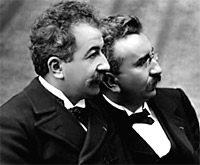history of indian cinema
1896 was a significant year for Indian entertainment as it witnessed the arrival of cinema in India. While discussing about the history of Indian cinema the first name that springs up is that of the Lumiere Brothers who demonstrated the art of cinema to the subcontinent. Bombay was the first Indian city that screened Cinematography, six short films by the Lumiere Brothers.
The success of these films led to the screening of more foreign films, for instance, Vitagraph by James B. Stewart and Moto-Photoscope by Ted Hughes. In other words introduction of cinema in India took place with the aid of the colonisers.
A kaleidoscopic view of history of India includes the pioneering efforts of Save Dada (Harischandra Sakharam Bhatavdekar) . He made two short films as early as in 1897. In 1900 the entire Indian entertainment sector underwent huge changes and the emergence of Dadasaheb Phalke took Indian cinema to new heights. Thus the path breaking film of the Silent era, Raja Harishchandra, was released in 1913.

A scene from Raja Harishchandra (1913) – The first full-length motion picture


Some stills from Alam Ara, India's first talkie movie, 1931
During this time and the era of the talkies the main sources for Indian films were the mythological texts. The rapid growth of the Indian cinema led to the end of the silent era and ushered in the era of the talkies. The latter introduced the Indian cinema in a completely new way to the audiences. Now one could hear the actors and actresses talk, laugh, sing and cry. Initially films were primarily made in Hindi, Tamil, Bengali and Telugu and these films proved to be phenomenal successes.

Devika Rani and Ashok Kumar in Achhut Kanya (1936).
1930s and 1940s witnessed the rise of film personalities, such as, Debaki Bose, Chetan Anand, S.S. Vasan, Nitin Bose and others. Their contributions helped the Indian cinema to grow further. By this time apart from Bombay (Mumbai), the film industry shaped up well in down south too. The Tamil, Telugu and Kannada film industries were making indigenous films as well. By late 1940s films in India were made in various languages but the religious influence was predominant. With struggle for independence the entire scenario altered. Indian cinema now saw films based on the then contemporary social issues. Movies no longer were limited to the periphery of entertainment; they were now potent instruments to educate the masses as well.

Guru Dutt in Pyaasa (1957), for which he was the director, producer and leading actor.
The golden period in the history of Indian cinema is attributed to the 1950s. Guru Dutt, Mehboob Khan, Raj Kapoor, Balraj Sahani, Nargis, Bimal Roy, Meena Kumari, Madhubala, Dilip Kumar graced the screens. In south India esteemed actors like Rajkumar, Gemini Ganesan, NT Rama Rao and several other actors and actresses entertained the audiences.

Nargis and Raj Kapoor in Awaara (1951), also directed and produced by Kapoor.
Besides them numerous singers, composers, scriptwriters, cameramen and other technicians lend a helping hand in making some of the most outstanding films that carved their own niches in the history of Indian cinema.
In Bombay while the magic of Guru Dutts and Bimal Roys were preponderant Indian cinema moved one step further with the release of K. Asif`s Mughal-e-Azam in 1960.

A trail of romantic movies followed all over India. While the Indian commercial cinema enjoyed popularity amidst the movie goers, Indian art cinema did not go unnoticed. Adoor Gopalakrishnan, Ritwik Ghatak, Aravindan, Satyajit Ray, Shaji Karun and several other art film directors were making movies that took India to international fame and glory. By 1970s Indian cinema enjoyed the histrionics of superstars like Rajesh Khanna, Sanjeev Kumar, Waheeda Rehman, Asha Parekh, Tanuja and others. This was truly the red letter year for Hindi cinema as Ramesh Sippy`s Sholay proved to be an iconoclast and gave to Indian cinema its new superstar--- Amitabh Bachchan. Hardly did anyone know then that the Bachchan era was here to stay for long enough.

At one hand Hindi cinema was growing in leaps and bounds and on the other the regional films were making their presence felt too. A number of well established Hindi film stars who became a part of the star system in India actually began their career with the Indian regional films. 1980s saw the rise of several woman directors, such as, Aparna Sen, Prema Karnath, Meera Nair and others. It was also the year when Rekha wooed the audiences with her stunning performance in Umrao Jaan. The regional films like Malayalam, Kannada, Telugu, Bengali and others produced a number of romantic films. Renowned film personalities like Balachander, I.V. Sasi, Balu Mahendra, Mani Ratnam, Ram Gopal Varma and others made their marks.
With romantic films at the helm the Indian cinema ushered into 1990s. A mixed genre was witnessed during this time. Romantic, thriller, actions and comic movies were made. Gradually the face of Indian cinema was undergoing changes one again. The audiences, too, were getting weary of similar storylines. Hence the contemporary Indian cinema, keeping pace with time and technology, witnessed dolby digital sound effects, advanced special effects, choreography, international appeal, further investments from corporate sectors alongwith finer scripts and performances. The aesthetic appeal of cinema became important for the filmmakers.
Stars like Shahrukh Khan, Rajnikanth, Madhuri Dixit, Aamir Khan, Chiranjeevi, Juhi Chawla, Hrithik Roshan and others explored all possible techniques to enrich Indian cinema with their performances. Even in contemporary India cinema remains a compelling device for creating mass awareness.
My post script:

Like the name of Hindi movie Kites, expect Indian cinema to soar further in the skies.
